There are 18 species of turtles in New Jersey. 13 of these species live in New Jersey’s brackish and freshwater areas, such as Northern Diamondback terrapins and Common Snapping turtles. Some of these species can be found all across the state, like Eastern Painted turtles. However, some are sadly threatened or endangered, such as the Bog turtle. Five species of Sea turtles are also known to visit New Jersey’s coastal waters.
The best way to use this list is as a herping guide for spotting New Jersey’s native turtles out in the wild. Alternatively, you can also use it as a jumping off point to help decide on your next pet turtle.
New Jersey’s turtle possession laws are fairly relaxed, and most native species can be kept as pets. Most species require a permit, although some are exempt from restrictions. The only prohibited species is the Bog turtle. However, no species except for Common Snapping turtles may be taken from the wild. It is also illegal to sell turtles inside New Jersey itself, and any purchased specimens have to be imported from elsewhere.
If you are considering one of New Jersey’s native species, please try and adopt a turtle from a local animal shelter if you can. If this isn’t practical, the next best thing is to purchase a captive-bred specimen from a registered breeder outside of New Jersey. Buying wild-caught animals harms native populations and should be avoided.
Now, let’s dive into the 18 species of turtles in New Jersey.
Turtles in New Jersey
1. Bog Turtle

- Experience Level: Beginner
- Family: Emydidae
- Scientific Name: Glyptemys muhlenbergii
- Other Names: Muhlenberg’s turtle
- Adult Size: 3.5 to 5 inches (9 to 12.5 cm)
- Lifespan: Up to 40 years
- Average Price Range: $250 to $450
Bog turtles are the smallest turtle species in North America and are also the state reptile of New Jersey. There are the only native species in the Garden State that cannot be owned as a pet. This is because they are Critically Endangered. Bog turtles can be found in most areas of New Jersey, but mostly in wetland habitats such as bogs or swamps in northwestern and southwestern areas.
Also known as Muhlenberg’s turtle, Bog turtles have keeled shells ranging from olive or dark brown to black. These diurnal turtles often have yellow or red star-like markings on their scutes. Bog turtles like humid areas and are most active during the warmest parts of the day.
Bog turtles are omnivores and mainly eat insects and mollusks along with occasional pieces of vegetation.
2. Eastern Box Turtle
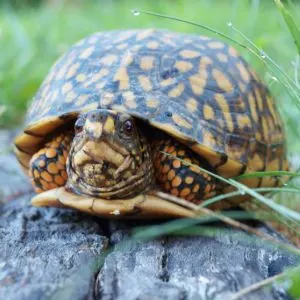
- Experience Level: Beginner
- Family: Emydidae
- Scientific Name: Terrapene carolina carolina
- Other Names: Common Box turtle, Land turtle
- Adult Size: 4 to 7 inches (10 to 18 cm)
- Lifespan: Up to 40 years
- Average Price Range: $120 to $400
Eastern Box turtles can be found in most regions of New Jersey despite being a species of Special Concern. These terrestrial turtles prefer grassland or woodland habitats that have some access to small water sources such as ponds.
Eastern Box turtles have highly-domed dark brown shells that are adorned with beautiful yellow and orange dots and stripes. More orange patterns can be seen on their brown skin. Their dark brown plastrons flat in females but concave in males.
These omnivores can roam up to 50 meters a day in search of food. Eastern Box turtles mainly consume small fish, insects, and mollusks along with fruits and other vegetation. They will also sometimes scavenge on carrion.
3. Northern Red-bellied Cooter

- Experience Level: Beginner to Intermediate
- Family: Emydidae
- Scientific Name: Pseudemys rubriventris
- Other Names: American Red-bellied turtle, Northern Redbelly Cooter, Redbelly turtle
- Adult Size: 8 to 12.5 inches
- Lifespan: 40 to 55 years
- Average Price Range: $30 to $170
Northern Red-bellied Cooters are one of North America’s largest freshwater turtles and can regularly be seen basking in the sun. In New Jersey, Northern Red-bellied Cooters inhabit rivers and ponds with soft bottoms in the state’s southern regions as well as a few northern counties.
Northern Red-bellied Cooters get their name from their red plastrons. These Cooters have black to dark brown to olive green shells that have reddish lines on some of their scutes. They also have yellowish markings on their skin.
Redbelly turtles are omnivorous and mainly feed on mollusks and invertebrates. As they get older, individuals will gradually eat more and more vegetation as part of their diet.
See our Cooter turtles page for more on cooters.
4. Northern Diamondback Terrapin

- Experience Level: Beginner to Intermediate
- Family: Emydidae
- Scientific Name: Malaclemys terrapin terrapin
- Other Names: Diamond-backed terrapin
- Adult Size: 4.5 to 9 inches (11.5 to 23 cm)
- Lifespan: 25 to 40 years
- Average Price Range: $250 to $300
Northern Diamondback terrapins are the only species in New Jersey that can tolerate brackish waters. They are usually found in tidal marshes or river estuaries along the coast. These fantastic turtles can often be seen swimming in the water with their heads poking out like periscopes.
Northern Diamondback terrapins have light gray skin speckled with black markings. These powerful swimmers also have thick webbed feet on their hind limbs. Their shells range from black to brown to gray, with concentric rings on their scutes.
As omnivores, Northern Diamondback terrapins feed on crustaceans, insects, mollusks, and shellfish such as clams or winkles. They will also occasionally eat vegetation for some variety.
See our Diamondback Terrapins page for all the subspecies.
5. Northern Map Turtle
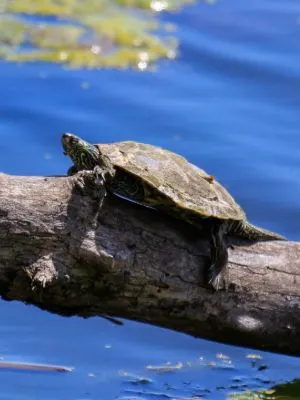
- Experience Level: Beginner
- Family: Emydidae
- Scientific Name: Graptemys geographica
- Other Names: Common Map turtle
- Adult Size: 4 to 10.5 inches (10 to 26.5 cm)
- Lifespan: 15 to 20 years
- Average Price Range: $20 to $60
Northern Map turtles are fantastic swimmers who can sometimes be seen basking at the edge of the water. These aquatic turtles are found in New Jersey’s larger river systems – mainly the Delaware River. They hardly ever venture far from the water.
Northern Map turtles get their name for the yellowish lines on their dark brown or olive green shells. These intricate markings call to mind the contours of a map. They also have a row of keels running down the spines of the shells. It can sometimes be hard to differentiate between different types of Map turtles, so Northern Map turtles are commonly distinguished by the small yellow spots behind their eyes.
These Map turtles are eat a mostly carnivorous diet of crustaceans, fish, and insects. They may also occasionally eat aquatic vegetation.
6. Eastern Mud Turtle
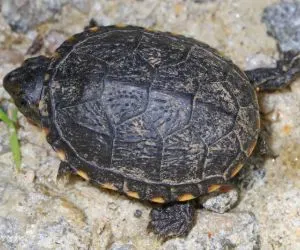
- Experience Level: Beginner
- Family: Kinosternidae
- Scientific Name: Kinosternon subrubrum
- Other Names: Common Mud turtle
- Adult Size: 3 to 5 inches (7.5 to 12.5 cm)
- Lifespan: Up to 50 years
- Average Price Range: $40 to $100
These small aquatic turtles inhabit shallow, slow-moving waters in bogs and swamps and prefer habitats with dense aquatic vegetation. Eastern Mud turtles are found in a few of New Jersey’s northern counties as well as in most of the southern half of the state.
Eastern Mud turtles have smooth, oval-shaped carapaces that range from brown to green to yellow. Their shells slope slightly at the front but drop quite abruptly at the back and sides. They have larger brown or yellowish-brown plastrons and their dark gray skin is often covered with mottled markings.
Eastern Mud turtles are omnivores, mainly eating small fish and mollusks. They will also eat aquatic vegetation occasionally.
7. Common Musk Turtle

- Experience Level: Intermediate
- Family: Kinosternidae
- Scientific Name: Sternotherus odoratus
- Other Names: Eastern Musk turtle, Stinkpot
- Adult Size: 4 to 5 inches (10 to 12.5 cm)
- Lifespan: 50+ years
- Average Price Range: $20 to $90
You might also recognize Common Musk turtles from their affectionate nickname – “Stinkpot” turtles. This moniker comes from the potent musk that they can excrete from their musk glands, which gives these small aquatic turtles a great defense mechanism. Stinkpots can be found across most of New Jersey in boggy or marshy habitats with clear, slow-moving waters.
Common Musk turtles have unmarked shells that range from black to dark brown to gray-green shells. They have dark skin and fleshy barbels on their chins and throats. Their long necks also sport two bright yellowish stripes.
Common Musk turtles are omnivores that mainly eat small amphibians, crustaceans, and mollusks. These nocturnal hunters rely on cover from dense aquatic vegetation to get close to their prey.
8. Eastern Painted Turtle
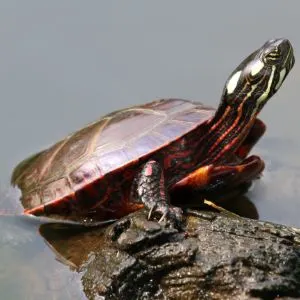
- Experience Level: Beginner
- Family: Emydidae
- Scientific Name: Chrysemys picta picta
- Other Names: N/A
- Adult Size: 4 to 10 inches (10 to 25.5 cm)
- Lifespan: 30 to 50 years
- Average Price Range: $20 to $50
New Jersey is home to one subspecies of Painted turtle – the Eastern Painted turtle. These medium-sized aquatic turtles are found across the state and prefer shallow waters such as marshes and ponds. Because they are so common in the wild, Eastern Painted turtles are one of two species that can be legally owned without a permit in New Jersey.
Eastern Painted turtles have black or dark brown shells and tan to yellowish plastrons. Their faces and throats have yellow stripe markings. Uniquely among Painted turtles, the scutes of Eastern Painted turtles run in parallel rows and have pale front edges.
Eastern Painted turtles are diurnal omnivores that mainly eat small fish or carrion along with plant matter. They can often be seen basking on logs above the water.
9. Red-eared Slider

- Experience Level: Beginner
- Family: Emydidae
- Scientific Name: Trachemys scripta elegans
- Other Names: Red-eared Terrapin, Water Slider turtle
- Adult Size: 6 to 8 inches (15 to 20 cm)
- Lifespan: 20 to 40 years
- Average Price Range: $15 to $50
Red-eared Sliders are one of the most popular turtle species in the herping hobby. These semi-aquatic turtles prefer warmer waters with slow-moving currents such as lakes or rivers. They can be found in most regions of New Jersey.
Red Eared Sliders have olive green shells with yellow stripes on their scutes. Their heads are usually a darker color, with yellow band markings and distinctive red patches just behind their eyes. These markings help to distinguish Red-eared Sliders from similar looking species.
These gluttonous omnivores mainly eat a diet of small fish, insects, and aquatic vegetation. They like to bask often and will sometimes stack themselves in towers at the water’s edge.
10. Common Snapping Turtle

- Experience Level: Intermediate to Expert
- Family: Chelydridae
- Scientific Name: Chelydra serpentina
- Other Names: Common Snapper, Eastern Snapping turtle, Snapper
- Adult Size: 8 to 20 inches (20 to 51 cm)
- Lifespan: 30 to 50 years
- Average Price Range: $20 to $40
Common Snapping turtles are the largest freshwater turtles in New Jersey and can be found in virtually any county in the state. These big brutes inhabit larger, permanent bodies of water like lakes, ponds, and reservoirs. They are one of only two native species in New Jersey that can be legally owned without a permit.
These Jurassic-looking turtles are famous for their powerful, hooked beaks, strong claws, and long tails covered with saw-toothed spines. Their thick dark brown or green shells have three prominent ridges in the center to complete their imposing appearance.
Common Snappers are the top dogs in the turtle food chain in most areas and will hunt prey in the deep waters of their habitats. They’ll happily eat amphibians, fish, smaller turtles, and even waterbirds if they can catch them. They may also occasionally eat aquatic vegetation.
11. Eastern Spiny Softshell Turtle
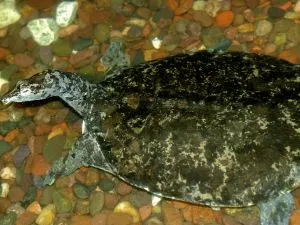
- Experience Level: Intermediate to Expert
- Family: Trionychidae
- Scientific Name: Apalone spinifera
- Other Names: N/A
- Adult Size: 5 to 17 inches (12.5 to 43 cm)
- Lifespan: 20 to 50 years
- Average Price Range: $70 to $280
Eastern Spiny Softshells are fast swimmers that need moving currents and specialized sandbar areas in their habitats, which are dwindling in number. They are usually found in rivers or streams in southwestern counties of New Jersey.
Eastern Spiny Softshells have oval-shaped shells that look like leathery pancakes. Their soft carapaces have dark spot markings along with a row of small spines towards the front edge of the carapace. They also have long, tapered snouts which they use to breathe while buried in the sand.
These Softshells are carnivores and lay in wait for crustaceans, small fish, insects, and mollusks that swim past their hiding place within the sand. The Spiny Softshell then strikes, catching their prey in their mouths.
12. Spotted Turtle

- Experience Level: Intermediate to Expert
- Family: Emydidae
- Scientific Name: Clemmys guttata
- Other Names: Polka-dot turtle
- Adult Size: 4 to 5 inches (10 to 12.5 cm)
- Lifespan: 25 to 50 years
- Average Price Range: $75 to $100
Spotted turtles are a species of Special Concern in New Jersey. They can be encountered in most regions of the state but usually keep a low profile. These turtles are semi-aquatic and inhabit boggy and marshy pools in wetland areas. They are dependent on certain types of aquatic vegetation, and habitat loss is a real danger for this species.
Spotted turtles are named for the bright yellow dots that cover their smooth shells, which are either black or dark brown. Their plastrons are also yellow and have large black patches of varying sizes on either side. They also have yellow, orange, or red patches on their cheeks and chins.
Spotted turtles are omnivores and will eat crustaceans, insects, and mollusks. They may also occasionally eat vegetation for some variety and nutrients.
13. Wood Turtle

- Experience Level: Intermediate
- Family: Emydidae
- Scientific Name: Glyptemys insculpta
- Other Names: N/A
- Adult Size: 5.5 to 8 inches (14 to 20 cm)
- Lifespan: 40 to 60 years
- Average Price Range: $250 to $500
Wood turtles are another rare species in New Jersey and are classed as Threatened. These intelligent turtles inhabit woodlands that contain shallow, slow-moving ponds. They are mainly found in the southern regions of New Jersey, but some populations exist in northeastern counties as well.
These turtles get their name from their dark brown shells, which are relatively flat and look as if they’ve been sculpted from wood. Their scutes may have markings that look a bit like wood grain or the growth rings on trees. Their shells have a rough texture and their scutes can protrude out, adding to their carved appearance.
Wood turtles are omnivores and mainly forage for berries, plants, insects, and mollusks. These ingenious turtles can also hunt worms by drumming their feet on the ground to simulate rainfall.
The coastal waters of New Jersey are often home to five species of Sea turtles. All of these turtles are considered Threatened or Endangered and their possession is strictly prohibited. We’ve put together a list of facts for each species as well as a link to a more detailed page.
Sea Turtles in New Jersey
Below are 5 of the 7 sea turtle species that exist in the world that have been seen in New Jersey.
14. Atlantic Green Sea Turtle
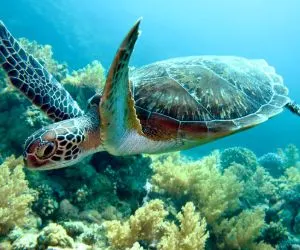
- Family: Cheloniidae
- Scientific Name: Chelonia mydas
- Other Names: Green Sea turtle
- Adult Size: 3 to 4 feet (90 to 120 cm)
- Weight: 300 to 400 lbs (135 to 180 kg)
- Lifespan: 80 to 100 years
- Conservation Status: Endangered
- Habitat: Bays and shores along coastlines and open ocean waters, seen during summer months
- Clutch Size: Around 110 to 115 eggs, with 2 to 5 clutches per breeding season
- Food: Mostly herbivores, eating algae, sea grasses and seaweed
- Appearance: Smooth green to brown shells shaped like hearts, edged in yellow. Cream colored scaly skin with shades of green
Head to our Green Sea turtles page for more information.
15. Atlantic Hawksbill Sea Turtle
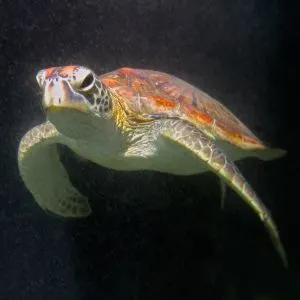
- Family: Cheloniidae
- Scientific Name: Eretmochelys imbricata
- Other Names: Hawksbill turtle
- Adult Size: 30 to 35 inches (76 to 89 cm)
- Weight: 100 to 155 lbs (45 to 70 kg)
- Lifespan: 30 to 50 years
- Conservation Status: Critically Endangered
- Habitat: Shallow coastal areas of rocky or tropical waters, reefs and estuaries
- Clutch Size: Between 140 to 200 eggs, about 4 clutches per breeding season
- Food: Omnivores, mainly consuming crustaceans, mollusks, and algae
- Appearance: Prominent, beak-shaped mouths (like a hawk), oval shells in shades of amber with unique markings. Flippers also have claws at their “elbows”
For more information, check out our Hawksbill Sea turtle page.
16. Kemp’s Ridley Sea Turtle

- Family: Cheloniidae
- Scientific Name: Lepidochelys kempii
- Other Names: Atlantic Ridley Sea turtle
- Adult Size: Around 25 inches (63.5 cm)
- Weight: 75 to 100 lbs (34 to 45 kg)
- Lifespan: Around 30 years
- Conservation Status: Critically Endangered
- Habitat: Sandy or muddy coastlines with shallow waters
- Clutch Size: Between 100 and 110 eggs, 2 to 3 clutches per breeding season
- Food: Crustaceans, shellfish
- Appearance: Slightly hooked beaks, triangle-shaped heads. Green to gray round shells. Muted cream or yellow plastrons and undersides.
Visit our Ridley sea turtle page for more information.
17. Leatherback Turtle

- Family: Dermochelyidea
- Scientific Name: Dermochelys coriacea
- Other Names: N/A
- Adult Size: 6 to 7 feet (182 to 213 cm)
- Weight: 1200 to 1450 lbs (545 to 658 kg)
- Lifespan: Around 30 years
- Conservation Status: Vulnerable
- Habitat: Warm waters, mainly shallow, calm bays or lagoons. Nests common on sandy beaches.
- Clutch Size: Between 100 and 110 eggs
- Food: Jellyfish is the staple of their diet, but they will also eat other sea creatures
- Appearance: Their large carapaces are soft, unique among sea turtles, with prominent ridges all the way down. Colors vary between black and a dark gray.
For more information, see our Leatherback sea turtle page.
18. Loggerhead Sea Turtle
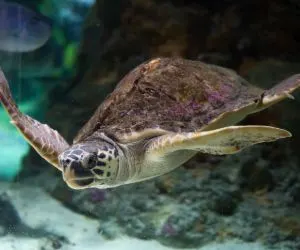
- Family: Cheloniidae
- Scientific Name: Caretta caretta
- Other Names: N/A
- Adult Size: 30 to 45 inches (76 to 114 cm)
- Weight: Approximately 155 pounds (70 kg)
- Lifespan: 70 to 80 years
- Conservation Status: Endangered
- Habitat: Coastal regions, mainly shallow bays. Prefer sub-tropical waters. Sandy ocean beaches for nesting
- Clutch Size: Between 100 and 125 eggs, 4 to 5 clutches per breeding season
- Food: Carnivorous, mainly eating shellfish, mollusks, and crustaceans
- Appearance: Largest hard-shelled turtles with a reddish-brown carapace and large heads. Undersides are cream to yellowish. Long powerful flippers
Check out our Loggerhead sea turtle page for more information.
Frequently Asked Questions about New Jersey’s turtles
What kind of turtles live in New Jersey?
18 species of turtle live in New Jersey, divided into 13 brackish and freshwater species – such as Common Snappers, Eastern Painted turtles, and Northern Diamondback terrapins – and five species of endangered Sea turtles that can sometimes be seen from New Jersey’s coastline.
New Jersey’s inland species inhabit a wide variety of habitats. Species such as Eastern Box turtles and Wood turtles are more terrestrial and can be found in grasslands or woodlands. Other turtles are fully aquatic and are only found in slow-moving or stagnant waters, such as Common Snappers and Bog turtles – the latter species is also the official State reptile of New Jersey.
Are turtles illegal in New Jersey?
New Jersey’s turtle laws are fairly relaxed compared to other states, although there are some quirks to be aware of. All of New Jersey’s 13 freshwater species can be legally owned as pets except for Bog turtles, which are Critically Endangered. Of this list, two species – Eastern Painted turtles and Common Snapping turtles – can be owned without needing a permit.
All other species require you to obtain the correct permit before they can be legally owned. Here’s where the quirk comes in; turtles can’t actually be sold within New Jersey itself. To obtain one of New Jersey’s native species, you must import them as captive-bred specimens from breeders in other states.
It is illegal to take any of New Jersey’s turtles from the wild (except for Common Snappers if you’re taking them for food), and it is also illegal to purchase wild-caught turtles from outside of New Jersey.
Conclusion
Well, that concludes our list of the 18 native species of turtles in New Jersey. We’ve delved into a range of reptiles from the Garden State, including brackish and freshwater turtles like the Northern Diamondback terrapin, Eastern Painted turtle, and Common Musk turtle. We also explored the five species of Sea turtles that can be seen in New Jersey’s coastal waters.
Whether you want to use this list as a field herping guide or a primer to help decide on your next pet turtle, we hope you enjoyed it! If you’re looking to obtain one of New Jersey’s native species as a pet, please keep the state laws and restrictions in mind when acquiring your turtle.
Please feel free to comment down below and discuss New Jersey’s native turtles with your fellow herping enthusiasts!
Other nearby states
- Turtles in Delaware
- Turtles in Maryland
- Turtles in New York
- Turtles in Pennsylvania
- Turtles in Virginia

Sharon
Friday 3rd of February 2023
I have been told by several environmentalists that the red eared slider is illegal in NJ and if you have one, to never let it go in the wild. Yet you name it as a native species. Can you explain?